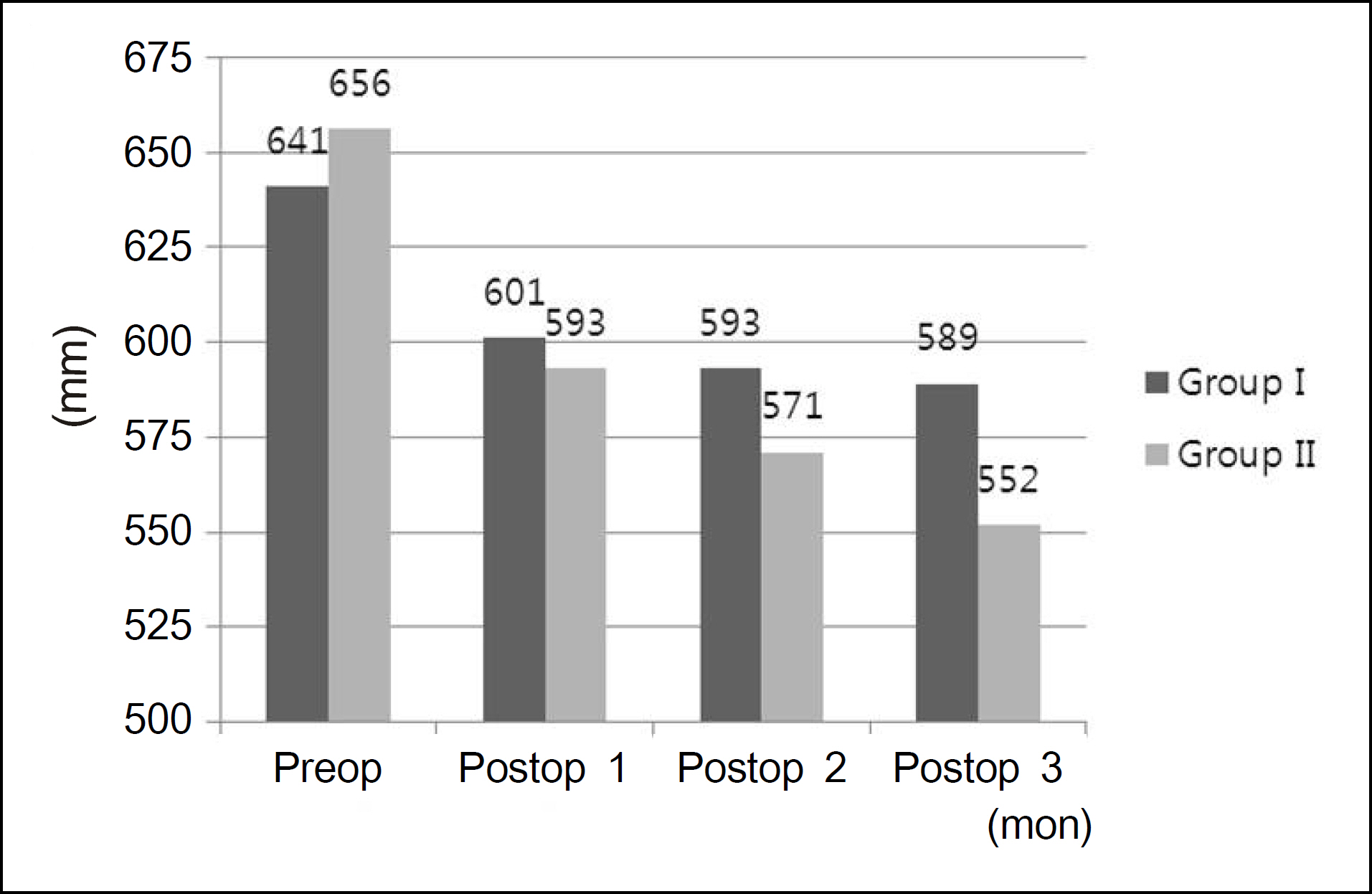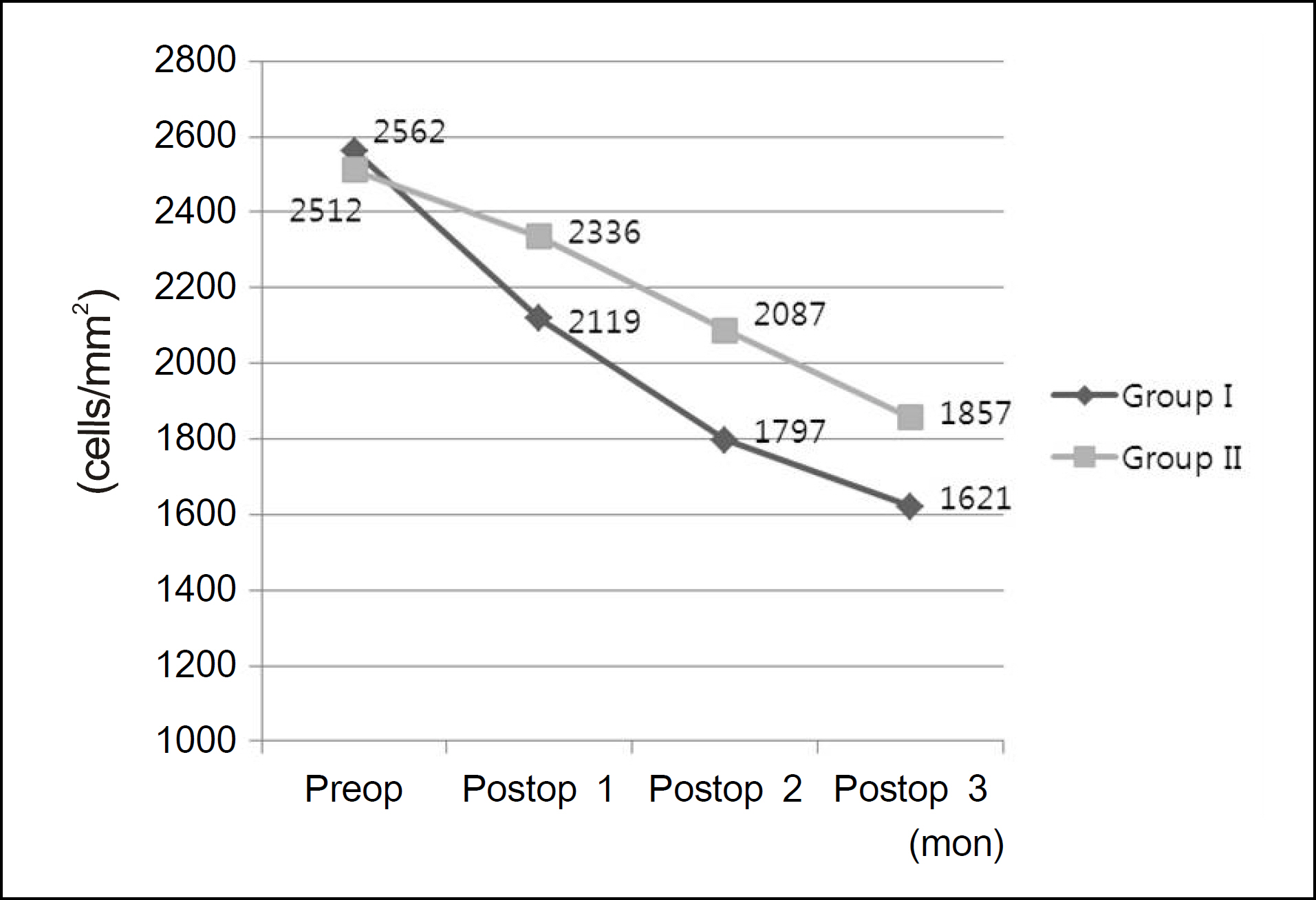J Korean Ophthalmol Soc.
2011 Aug;52(8):916-921. 10.3341/jkos.2011.52.8.916.
The Effect of Intraocular Lens Insertion Sequence during the Triple Procedure on Corneal Endothelial Cell Survival
- Affiliations
-
- 1Department of Ophthalmology and Visual Science, Seoul St. Mary's Hospital, The Catholic University of Korea College of Medicine, Seoul, Korea. mskim@catholic.ac.kr
- KMID: 2214767
- DOI: http://doi.org/10.3341/jkos.2011.52.8.916
Abstract
- PURPOSE
To evaluate the differences in corneal endothelial cell density in patients undergoing intraocular lens insertion at 2 different sequences during the triple procedure.
METHODS
The present retrospective study divided 37 eyes of 37 patients and into 2 groups: trephination, phacoemulsification and intraocular insertion, followed by graft suturing (20 eyes, Group I), and trephination, phacoemulsification, graft suturing leaving 3 mm gap, followed by intraocular lens insertion and suturing of the gap (17 eyes, Group II). Intraocular pressure, corneal thickness, and endothelial cell density were measured for 3 months postoperatively.
RESULTS
No significant difference in intraocular pressure between the 2 groups (p = 0.14) was observed. However in Group II, the mean corneal thickness showed a greater decrease (p = 0.02) during the 3 months following surgery, and the mean corneal endothelial cell density in this group was higher at 1, 2, and 3 months postoperatively than that of Group I (p = 0.01, 0.02 and 0.04 respectively). There were no significant difference in the rate of endothelial cell loss during the postoperative period between the 2 groups.
CONCLUSIONS
The anterior chamber formation before intraocular lens insertion in the triple procedure is hypothesized to decrease corneal endothelial cell loss by minimizing mechanical contact with intraocular structures or intraocular lenses during surgery.
Keyword
MeSH Terms
Figure
Cited by 1 articles
-
Laser Iridotomy-Induced Bullous Keratopathy in Korea: Clinical Features and Comparison with Pseudophakic Bullous Keratopathy
Seung Yong Choi, Soon Il Choi, Sung A Lim, Man Soo Kim
J Korean Ophthalmol Soc. 2016;57(1):14-19. doi: 10.3341/jkos.2016.57.1.14.
Reference
-
References
1. Katzin HM, Meltzer JF. Combined surgery for corneal transplantation and cataract extraction. Am J Ophthalmol. 1966; 62:556–60.
Article2. Taylor DM. Keratoplasty and intraocular lenses. Ophthalmic Surg. 1976; 7:31–42.
Article3. Taylor DM, Khaliq A. Keratoplasty and intraocular lenses: follow-up study. Ophthalmic Surg. 1977; 8:49–57.
Article4. Taylor DM, Khaliq A, Maxwell R. Keratoplasty and intraocular lenses: current status. Ophthalmology. 1979; 86:242–55.
Article5. Hunkeler JD, Hyde LL. The triple procedure: combined penetrating keratoplasty, extracapsular cataract extraction and lens implantation. An expanded experience. J Am Intraocul Implant Soc. 1983; 9:20–4.
Article6. Skorpik C, Menapace R, Gnad HD, Grasl M. The triple procedure– results in cataract patients with corneal opacity. Ophthalmologica. 1988; 196:1–6.7. Binder PS. The triple procedure. Refractive results. 1985 update. Ophthalmology. 1986; 93:1482–8.8. Meyer RF, Musch DC. Assessment of success and complications of triple procedure surgery. Am J Ophthalmol. 1987; 104:233–40.
Article9. McCartney DL, Gottsch JD, Stark WJ. Managing posterior pressure during pseudophakic keratoplasty. Arch Ophthalmol. 1989; 107:1384–6.
Article10. Inoue Y. Corneal triple procedure. Semin Ophthalmol. 2001; 16:113–8.
Article11. Kim MK, Lee JH. Long-term outcome of graft rejection after penetrating keratoplasty. J Korean Ophthalmol Soc. 1997; 38:1553–60.12. Patel SV, Hodge DO, Bourne WM. Corneal endothelium and postoperative outcomes 15 years after penetrating keratoplasty. Am J Ophthalmol. 2005; 139:311–9.
Article13. Bourne WM, O'Fallon WM. Endothelial cell loss during penetrating keratoplasty. Am J Ophthalmol. 1978; 85:760–6.
Article14. Kramer SG, Stewart HL. Maintenance of the anterior chamber during penetrating keratoplasty. Trans Sect Ophthalmol Am Acad Ophthalmol Otolaryngol. 1976; 81:794–805.15. Kirkness CM, Ling Y, Moshegov C. Penetrating keratoplasty and raised intraocular pressure. A brief review of the problems and its management. Ann Acad Med Singapore. 1989; 18:168–70.16. Simmons RB, Stern RA, Teekhasaenee C, Kenyon KR. Elevated intraocular pressure following penetrating keratoplasty. Trans Am Ophthalmol Soc. 1989; 87:79–91. discussion. 91–3.17. Seitz B, Langenbucher A, Nguyen NX, et al. Long-term follow-up of intraocular pressure after penetrating keratoplasty for keratoconus and Fuchs' dystrophy: comparison of mechanical and Excimer laser trephination. Cornea. 2002; 21:368–73.18. Nguyen NX, Langenbucher A, Seitz B, et al. Impact of increased intraocular pressure on long-term corneal endothelial cell density after penetrating keratoplasty. Ophthalmologica. 2002; 216:40–4.
Article19. Burke S, Sugar J, Farber MD. Comparison of the effects of two viscoelastic agents, Healon and Viscoat, on postoperative intraocular pressure after penetrating keratoplasty. Ophthalmic Surg. 1990; 21:821–6.
Article20. Langenbucher A, Seitz B, Nguyen NX, Naumann GO. Corneal endothelial cell loss after nonmechanical penetrating keratoplasty depends on diagnosis: a regression analysis. Graefes Arch Clin Exp Ophthalmol. 2002; 240:387–92.
Article21. Gil SY, Park CK, Hahn TW. Evaluation of donor corneal endothelium after keratoplasty. J Korean Ophthalmol Soc. 2006; 47:519–24.22. Chung SH, Kim HK, Kim MS. Corneal endothelial cell loss after penetrating keratoplasty in relation to preoperative recipient endothelial cell density. Ophthalmologica. 2010; 224:194–8.
Article23. Sud RN, Loomba R. Achievement of surgically soft and safe eyes–a comparative study. Indian J Ophthalmol. 1991; 39:12–4.24. Guindon B, Harvey J, Peacocke A, et al. Factors modifying vitreous pressure in cataract surgery. Can J Ophthalmol. 1981; 16:73–5.25. Shimomura Y, Hosotani H, Kiritoshi A, et al. Core vitrectomy preceding triple corneal procedure in patients at high risk for increased posterior chamber pressure. Jpn J Ophthalmol. 1997; 41:251–4.
Article26. Konomi K, Shimazaki J, Shimmura S, et al. Efficacy of core vitrectomy preceding triple corneal procedure. Br J Ophthalmol. 2004; 88:1023–5.
Article
- Full Text Links
- Actions
-
Cited
- CITED
-
- Close
- Share
- Similar articles
-
- Estimaionof Intraocular Lens Power in Penetration Keratoplasty Combined with Intraocular Lens Implantation
- Long Term Corneal Endothelial Cell Density Loss after Iris-fixed Phakic Intraocular Lens Implantation
- Effect of Dorzolamide on Corneal Endothelium
- The Effect of Healon(R) and Metrol(R) on Cornea and Intraocular Pressure in Extracapsular Cataract Extraction with Posterior Chamber Lens Implantation
- Long-term Change in Corneal Endothelium After Iris-fixed Phakic Intraocular Lens Insertion



